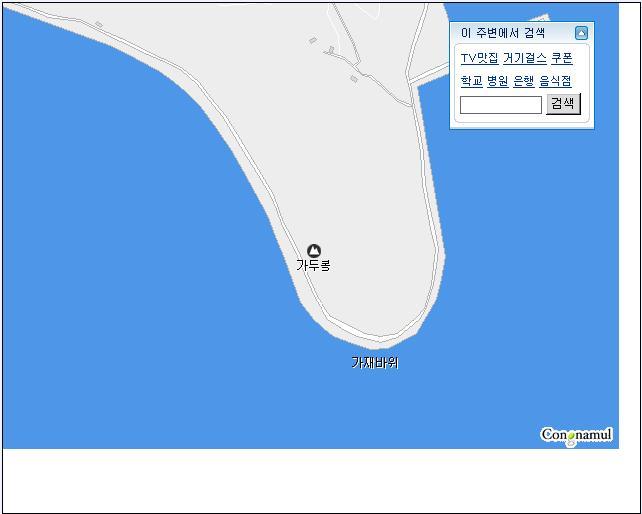There are two things about the map that I find especially interesting. One is that it shows two fairly large rocks south of Jukdo, just off the east shore of Ulleungdo. One of the rocks is labeled 胄島 (Judo), with the name "北苧岩" in parentheses. Judo (胄島) means "Helmet Island" and may have been the Japanese name for the islet since there is no Japanese pronunciation guide written above the name. At any rate, this is evidence that even rocks were referred to as "islands." By the way, there is a rock off the northern shore that is labeled as an "island": 一本立島 (竹岩).
The second thing about the map that interests me is the name of the peak on the southern tip of the island. The peak is labeled as 可頭峰 (가두봉 - Gadu Peak), which I think translates as "Seal Head Peak." Koreans used to refer to the sea lions on Ulleungdo as "Gaji-eo" (可支魚), of which the first character is the same as the first character in the name of the peak. Old Western maps also labeled that part of the island as "Seal Point." If you look closely at the map, you should notice a small islet just offshore of "Seal Point." Modern Korean maps show the name of this rock as "Gajae Bawui" (가재바위), which means "Sea Lion Rock" (可支岩) in the Ulleungdo dialect. (See the second map below.)
I think it is very likely that "Sea Lion Rock" was the place referred to as "Gajido" (可支島) in a 1794 Korean survey report of Ulleungdo since "Gajido" means "Sea Lion Island" and since rocks were also referred to as islands. "Geobuk Bawui" (거북바위 - Turtle Rock), on the southwest coast of the island, could have also been Gajido since it is very close to a seashore cave that was labeled as "Gaji Cave" (可支窟 - Sea Lion Cave) on Lee Gyu-won's 1882 map of Ulleungdo. Today, the cave is called "Gajae Cave" (가재굴), which again means "Sea Lion Cave" in the Ulleungdo dialect. Koreans claim that Gajido was another old Korean name for "Dokdo" (Liancourt Rocks), but they have no maps or documents to support that claim. Besides, since Gajido was mentioned in a survey report of Ulleungdo, not Liancourt Rocks, it is almost certain that it was just one of Ulleungdo's neighboring rock islets.


Gerry,
ReplyDeleteThe map shows that 観音島 and 島項嘴 are different places. 島項 may be the part of the protrusion to the island 観音島.
And I'm interested in the name 大芋浦 at just the southeast coast, but there is not 小芋浦.
I have a copy of this map. The map is called 「鬱陵島図」 by 朝鮮総督府 in 1918. It has Korean pronouciation besides 漢字 and contour lines. It says 慶尚北道 鬱陵島
ReplyDeleteI think it says "冑島(北苧岩)". "冑" means helmet. Since it has no Korean pronouciaion labelled for 冑島, maybe, it's an Japanese name?
BTW, "石圃洞" is still called "Sok-po-Don", and "石門洞" is called "Sok-Mun-Don"in this map. Aren't there any modern kind of this map in Korea?
Thank you, Kaneganese. I have added your information to the post, and I have also made a few other changes to the post. It was late, and I was tired last night when I wrote it.
ReplyDeleteActually, I have not found any Korean maps of Ulleungdo that are as detailed as this Japanese map, but THIS MAP is pretty good. A problem with most Korean maps of Ulleungdo, however, is that they do not show the placenames with their original Chinese characters. A decision seems to have been made to Koreanize many of the placenames on Ulleungdo. I cannot help but think they are trying to hide something.
By the way, if you look up "Ulleungdo" (울릉도) in some of Korea's online encyclopedias, you will notice that the description is only a few paragraphs, but if you look up "Dokdo," you get a long description of a dozen or more paragraphs. Does that make sense? Actually, we probably have more information on Ulleungdo on this site than any Korean site.
Pacifist,
ReplyDeleteYes, that protrusion pointing toward Gwaneumdo is called "Seom-mok" (섬목) on Korean maps, which is the Korean for "島項."